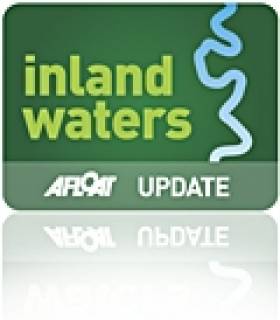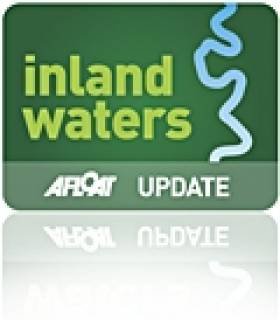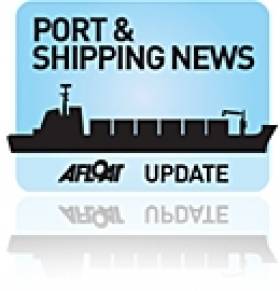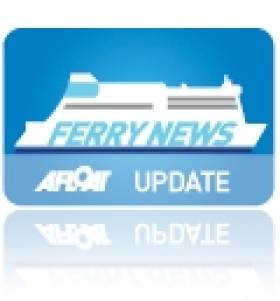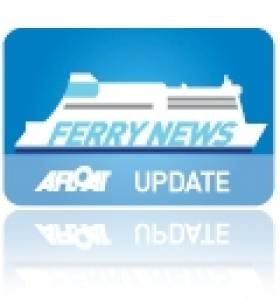Displaying items by tag: Lough foyle
Young Porpoise In Distress In Lough Foyle
#MarineWildlife - The Irish Examiner reports on efforts to save an injured porpoise calf that was found beached on the shores of Lough Foyle yesterday (25 February).
Local people managed to help the young marine mammal, which has a wound on its tail fin, back into deeper water - but strong wind and wave action forced it into the stream of the Bredagh river.
It currently appears to be struggling in the mix of saltwater and freshwater, the latter of which can cause kidney and skin serious problems if cetaceans are exposed to it for extended periods.
The Irish Examiner has more on the story HERE.
'Monster' Sighting In Lough Foyle Causes A Stir
#LoughFoyleMonster - Could Lough Foyle be hiding its very own version of the legendary Lough Ness Monster? As the video above attests, some witnesses to a mysterious sighting in the lake recently seem to think so.
According to The Canadian, a glimpse of what appears to be a large rock-like creature just breaching the surface of the water was captured by a group on the lough.
“It's really difficult to determine what species of creature it was," said one of the group. "I really don't think this can be a whale. I've seen whales, but I've never seen one swim like this before. Also, the pattern on it doesn't really look like it’s a whale.”
But before we all get too excited, consider that the group who made the video admitted that they were shooting for a student film called Fishing With David Lynch - a film and TV director well known for his other-worldly twists on reality.
'Submarine Wreck' in Lough Foyle is Just an Illusion
#INLAND WATERWAYS - It was a hotly anticipated find - but the image of what appeared to be a rare German submarine in the depths of Lough Foyle turned out to be a ghost.
RTÉ News reports that a team brought in to verify a sonar image captured by a search and rescue team from Mallow have confirmed that it was a 'sonic illusion'.
Northern Ireland's Environment Minister Alex Attwood called in the experts after the search team discovered what looked like the outline of a midget U-boat on the lough bed near Derry.
The possibility was a real one, as the lough had been a major naval base during the Second World War.
But a full survey of the lough revealed that the original image was an apparition caused by sonar distortion.
"There is no doubt for a moment there was a thrilling possibility which has now not come to pass," said the minister. "I do share a sense of disappointment."
RTÉ News has more on the story, including images and video, HERE.
Foyle Ferry Returns to Service
#FERRY NEWS – After a gap of six months the Greencastle-Magilligan ferry service across Lough Foyle reopened over the St. Patrick's weekend, writes Jehan Ashmore.
The return of the 10-minute cross border route, which offers an alternative to a road journey of nearly 80kms /50 miles was announced by Donegal County Council and Limavady Borough Council.
As previously reported on Afloat.ie, the route operated by Lough Foyle Ferry Company is a joint initiative of the two councils and for the remainder of this month the service will be running to a weekend-only schedule.
Sailings however are to increase to a regular daily service, subject to weather conditions, between 1st April-30th September.
For more information visit www.loughfoyleferry.com
Cruise Liners Line-Up for Foyle
#CRUISE LINERS-Aside the main ports where most cruise ships visit while touring this island, Londonderry would be a less frequent destination, as such vessels only began visiting the north-west port since 1995, writes Jehan Ashmore.
Some of the leading operators though have called over the years called to the port, they are: Crystal Cruises, Cunard Line, Residensea, Seabourn and Silverseas.
This year's line-up will see eight scheduled calls starting in May with the 446 passenger Quest for Adventure (for more click HERE) built in 1981 and operated by Saga Cruises. A younger near-sister Astor built in 1987 is also due to call in August.
Below is a list of the cruise callers and dates.
Quest for Adventure 9 May
Marco Polo 14 July
Prinsendam 16 July
Astor 11 August
Clipper Odyssey 18 August
Princess Daphne 30 August
Albatross 12 September
Ocean Countess 15 September
The vessels will use various berths dependent upon size within the port which is run by the Londonderry Port and Harbour Commissioners. The facilities are at the city quays, Lisahally or require anchorage off Greencastle in Lough Foyle.
Former Dutch Dredger on the Boyne
#PORTS & SHIPPING- Berthed at the Steam Packet Quay, Drogheda is the suction-trailer dredger Lough Foyle (1979/868grt) which is on contract work with the Drogheda Port Company, writes Jehan Ashmore.
Following the sale last month of Hebble Sand, as previously reported on Afloat.ie (clcik HERE), the Lough Foyle (PHOTO) is now the only port-owned dredger on the island of Ireland. The Londonderry Port & Harbour Commissioners (LPHC) purchased the vessel from Dutch interests in 2009. She was originally the Saeftinge, built in 1979 at the Van Goor Scheepswerf in Monnickendam.
Since her introduction she has performed previous dredging operations to include the Drogheda Bar leading into the Co. Louth port. Her most recent contract was in Waterford Estuary, from where she arrived from on Tuesday after an overnight voyage.
In addition she has worked at the new Stena Line ferryport terminal at Loch Ryan, Cairnryan, to see related report click HERE. The Scottish ferryport is due to be officially opened tomorrow, to read more including the newly introduced 'Superfast' sisters click HERE.
Former Dundalk Dredger Sold in Dublin Port
#DUBLIN PORT-The former Dundalk Port Company grab-hopper dredger Hebble Sand (1963/757grt), which has been laid-up in Dublin since last Summer, was sold to new owners a month ago, writes Jehan Ashmore.
She remains berthed at the Bulk Jetty, Alexandra Basin, where she arrived from the Co. Louth port on 14 July, two days after the assets, liabilities and operations of Dundalk Port Company were transferred to Dublin Port Company by an order of statutory instrument. Against this background, Dublin Port Company decided to divest in the business of dredging resulting in placing the veteran vessel for sale.
During her career in Drogheda, she was the only dredger to be operated and owned by a port company apart from the suction-trailer dredger Lough Foyle (1979/868grt) operated by Londonderry Port & Harbour Commissioners.
Hebble Sand, registered in Dundalk has retained her original name since her launch from Richard (Shipbuilders) of Lowestoft for British Dredging. She has been kept in good condition considering a career nearing five decades. To read some of her last contracts undetaken outside her homeport, click HERE.
From a distance some people have mistaken Hebble Sand (PHOTO) to the last of the 'Guinness ships, as she bores a resemblance to the final custom-built stout tanker Miranda Guinness ( PHOTO), taken on her farewell sailing. The vessels shared a similar red funnel and black funnel, a roomy sized superstructure painted in cream above and a dark blue hull. To read more about the last of the brewery tanker-fleet click HERE.
Donegal-Derry Ferry Route Closes
According to the Lough Foyle Ferry Company website, the directors sincerely hope that the suspension of the service will be temporary and look forward to re-commencing operations in early 2012.
The 10-minute crossing served by the 300-passenger / 44-vehicle capacity Foyle Venture (photo) provided year-round sailings. During the summer months the schedule was increased to a continuous shuttle-service as it provided a convenient short-cut for Northerners heading to Donegal.
Motorists could save nearly 80 kms (50 miles) by travelling across the Inishowen Peninsula instead of having to drive through London/Derry. In its third year of operations, the company carried its one-millionth passenger and since then the route has exceeded 2m passegers.
Bikini Registered Motoryacht Follows Cruiseship Out of Dublin
As for Cary Ali, she is a 87ft long was built in 2007 by Nordhavn to a design of Jeff Leishman. From her stern flew the flag of the Marshal Islands in the Pacific Ocean. Inside the four-decked vessel there is the main salon, a dining room, galley and three guest staterooms, and a master cabin (click HERE). In total eight people can be accommodated. In addition she has a jacuzzi, fly-bridge and is equipped with a tender and has crew of four.
She has a speed of 24-knots and is equipped with 50hp bow and stern thrusters. To read more about the luxurious motoryacht including facts and figures click HERE.
The Cary Ali had berthed at the 100-berth marina of the Poolbeg Yacht & Boat Club which caters lesiure craft up to 20 metres and is centrally located on the south side of Dublin Port. The facility has accommodated larger motoryachts over the years. Though even larger motoryachts such as Battered Bull, a Feadship 52m has berthed further upriver at Dublin City Moorings.
- motorboats
- Carlingford Lough
- Dublin Port
- Cruise Liners
- Ports and Shipping
- Lough foyle
- Poolbeg Marina
- motor yacht
- Marshall Islands
- Dublin City Moorings
- Cruise ships
- Greencastle Co.Donegal
- Greencastle Maritime Museum
- Hebridean Princess
- Caly Ali
- MY Caly Ali
- Charter motoryachts
- Motor boat news
- Lough Foyle Ferry Company
Lough Foyle Ferry Service To Cease
A notice on each pier says the Lough Foyle Ferry Company regrets the service will be suspended from the close of business on Sunday, October 2nd. The notices say directors of the company hope the suspension will be temporary, and they look forward to recommencing operations early in 2012.
For a photo of the ferry that once served on the Shannon (Killimer-Tarbart) service as Shannon Willow click HERE. Note in the background is the veteran cruiseship Princess Daphne at anchor in Lough Foyle. To read more about the ferry service visit www.loughfoyleferry.com/main.htm




























